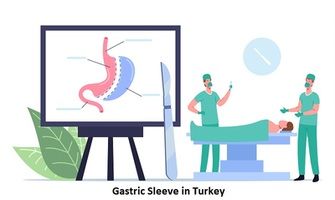
Medically reviewed & verified by: Prof. Dr. Halil Alis
Written by: ClinicAdvisor Team
What is Gastric Bypass?
Gastric Bypass is one of the common weight loss surgeries performed for those who suffer from obesity. It aims to reduce the size of the stomach and change the way the stomach and small intestine absorb food. Which eventually facilitates the process of losing weight. It’s recommended for people with a BMI of 40 or more.
The procedure helps lose weight in two mechanisms: restriction and malabsorptive. Restriction in that it limits the food intake and the ability of the stomach to hold food. On the other hand, malabsorptive means reducing the ability of absorbing calories.
How is Gastric Bypass in Turkey Performed?
Gastric bypass in Turkey is done by dividing the stomach into two parts: the small upper part, which is known as the “stomach pouch,” and the lower part, which is larger.
The upper part is then attached to a portion of the small intestine, thus making the food pass from the new gastric pouch directly to the intestine. The operation is done under general anesthesia and through keyhole incisions on the abdominal wall.
 Gastric Bypass in Turkey
Gastric Bypass in Turkey
Gastric bypass surgery requires between 2-3 days hospitalization to closely monitor the condition of the patient.
Gastric Bypass Candidates
In order to be qualified for a gastric bypass patients must meet the following criteria:
- To be at least 18 years old. Although in some cases younger patient can also get the surgery if it’s required.
- Body Mass Index (BMI) of 40 or more.
- BMI of 35 or more for those with obesity related diseases such as diabetes, hypertension, heart diseases, and sleep apnea.
- Individuals with multiple attempts to lose weight the traditional way but with no results.
- Those who are ready to commit to a new lifestyle in terms of eating and exercising.
Mini Gastric Bypass vs Traditional Gastric Bypass
The mini gastric bypass was created by Dr. Robert Rutledge in 1997 in an attempt to reduce the length of the procedure. And also, to slightly reduce the complications associated with the traditional gastric bypass.
Although both work in the same manner but below are the main differences between mini and traditional gastric bypass:
Technique Used
In terms of how the mini gastric bypass is performed, surgeons create a long narrow tube of the stomach instead of a small pouch. After that they reroute a lower part of the small intestine and connect it with the narrow stomach tube.
Unlike the traditional gastric bypass where a small upper pouch of the stomach is created. Then the small intestine is separated and the lower section is attached to the new stomach pouch. And finally, the upper part of the small intestine is connected again to the lower part of it. This allows fluid from the liver and pancreas to be digested.
Cost
The cost of mini gastric bypass is cheaper than the traditional one.
Duration
The time it takes to perform a mini gastric bypass is shorter as compared to the traditional gastric bypass.
Complications
It’s said that the complications associated with gastric bypass are reduced with the mini gastric bypass method.
What is the Cost of Gastric Bypass in Turkey?
The average cost of gastric bypass in Turkey ranges between $3500 - $4000. The price varies among hospitals based on the experience of the surgeon, the technique used and location.
Gastric Bypass Weight Loss Chart
After gastric bypass patients should expect to lose 70-80% of their excessive weight following a balanced diet and exercise program. Below is a chart which shows the gastric bypass weight loss timeline:
 Gastric Bypass Weight Loss Chart
Gastric Bypass Weight Loss Chart
Gastric Bypass: Pros and Cons
Pros:
- Weight loss is faster compared to gastric sleeve.
- Lower risk of type 2 diabetes and heart diseases.
- Improved levels of cholesterol and sleep apnea.
- Joint pain relief
Cons:
- Permanent and irreversible.
- Deficiency of some nutrients and vitamins.
- Dumping syndrome.
- Gastric leakage.
- Recovery is longer than gastric sleeve.
Gastric Bypass Side Effects and Complications
Some potential complications could happen after gastric bypass. Some of these complications are rare or can be prevented if done by an experienced surgeon.
These complications may include:
- Wound infection.
- Leakage.
- Bleeding.
- Blood clots.
- Anastomotic ulcer.
- Gallstones.
- Malnutrition.
- Bowel obstruction.
- Dumping syndrome, which causes diarrhea, nausea and vomiting.
- Hernia inside the abdomen.
Gastric Bypass Recovery and Post-Op Instructions
Once the operation is finished you will be required to stay at the hospital for 2-5 days depending on the type of surgery you had. For an open surgery, the duration is longer than the one done laparoscopically.
Here are some of the things you should expect after the surgery:
- During the first few hours after you wake up from the surgery a nurse will closely monitor your vital signs and your overall health.
- After you wake up you won't be able to eat anything except drink small sips of water to stay hydrated. A detailed diet after gastric bypass will be discussed below.
- You will be given some breathing exercises to prevent pneumonia.
- The nurse will help you move your legs and wear a compressing stocking to prevent blood clots.
- You can take a shower 5 days after your surgery but make sure to avoid soaking the incision area and keep it dry. You can wipe the wounds with a wet towel and a mild soap then pat it dry.
- Avoid bathing and swimming for 3-4 weeks.
- The wound area will be covered with a tape called steri-strip. Your surgeon will tell you how to change it and when it will be removed.
- A urine catheter will be attached to your bladder to remove urine.
- You may also have a drainage to remove fluids.
- You can return back to work after 2-3 weeks depending on the nature of your job. If it's physically demanding you might need to wait a bit longer. Check with you surgeon when would be the best time to go back to work.
- Avoid any strenuous activities including working out, swimming, lifting heavy objects for the first 3-6 weeks.
- Stay hydrated by drinking 1.5 to 2 liters of water daily.
- You won't be allowed to drive for the first couple weeks after your surgery. So, make sure you have someone to help you with your grocery shopping.
Gastric Bypass Diet Plan
Since the stomach needs time to heal, the dietary plan will consist of liquids for the first 3-4 weeks. Kindly note that this is a general gastric bypass diet program which is shared for informative purposes. However, we urge you to follow he program your nutritionist has prepared for you.
The first stage: Only Liquids
For a few days after the operation you will be allowed to drink clear liquids only. These can be liquids such as water, apple juice, orange juice etc. Remember to drink slowly and in small sips.
If you can tolerate clear liquids, your doctor will tell you when to add different kinds of liquids such as clear soup, decaffeinated coffee or tea and skimmed milk.
The Second Stage: Puréed Food
All foods should be in the form of purée food with a consistency similar to mashed potatoes or pudding. To increase the intake of protein you can add skimmed milk powder to whole foods and drinks. Food you can eat during this stage are:
- Skim milk.
- Fruits and vegetables (well blended).
- Meat, chicken and fish.
- Blended Legumes.
- Low-calorie-fat-free cheeses.
- Unsweetened yogurt.
The Third Stage: Soft Food
Soft foods are now added to your nutritional list after gastric bypass. You can start eating soft, chewy foods, cooked, peeled vegetables, minced meat and canned fruits.
The Last Stage: Solid Food
At about 2 months after the operation you may start introducing solid foods to your dietary program. Patient are given a new list to follow. This list continues to be applied until 1 year after the operation or as your doctor recommends.
These are some general instructions to be followed:
- Consume foods low in fat and sugar.
- Eat slowly and chew thoroughly.
- Drink liquids between meals, not with meals.
- Consume foods high in protein and less calories to provide satiety.
- Try to change the food you eat from time to time so as not to get bored of the same food.
- If there are supplements recommended by your doctor, use them constantly.
Questions & Answers
Does a gastric bypass leave visible scars? Since gastric bypass is laparoscopically done then the incisions are very tiny and heals with time. Also, by using some certain creams it helps get rid of any scars. | Is gastric bypass surgery painful? Gastric bypass is performed under general anesthesia meaning that the patient will not feel anything. After the operation and once the effect of the anesthetic starts fading away pain killers are given to patients to relief the pain. |
Is gastric bypass reversible? Gastric bypass is non-reversible unlike a gastric band or gastric balloon. | |
SOURCES:
- Mayo Clinic: Gastric Bypass (Roux-en-Y)
- John Hopkins Medicine: Roux-en-Y gastric bypass weight-loss surgery.
- Healthline: Your Guide to the Gastric Bypass Guide
- Medline Plus: Gastric Bypass Surgery
- Wikipedia: Gastric Bypass Surgery
- Webmd: Gastric Bypass Surgery








Share Your Opinion, Please